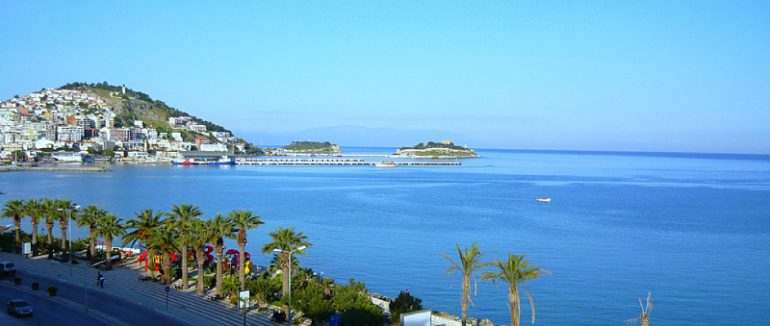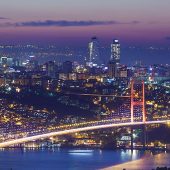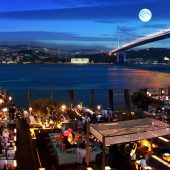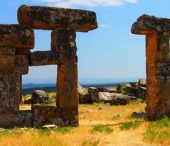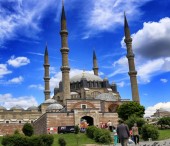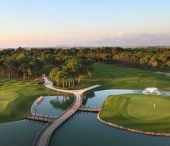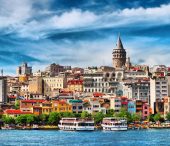Aydın is the heart of the lower valley of Büyük Menderes River (Meander River) down to the Aegean Sea, a region that has been known for its fertility and productivity since ancient times. Today the best-known crop is figs, although the area grows other agricultural products, has some light industry and the province of Aydın also contains some internationally known historic sites and centers of tourism. The weather is hot in summer, and warm all year round.
Etymology
Once the ancient city of Tralles and then Güzelhisar, the city was later named after the Anatolian Turkish Beylik of Aydınoğlu, which ruled here in the 14th century.
History
Antiquity
In ancient Greek sources, the name of the city is given as "Anthea" and "Euanthia". During the Seleucid period, it received the name "Antiochia" (Greek: Αντιόχεια). At other times it was also called "Seleucia ad Maeandrum" and "Erynina". In Roman and Byzantine times, it was known as "Tralles" or "Tralleis", and was one of the largest Aegean cities in antiquity.
According to Strabo Tralles was founded by the Argives and Trallians, a Thracian tribe. Along with the rest of Lydia, the city fell to the Persian Empire. After its success against Athens in the Peloponnesian War, Sparta unsuccessfully sought to take the city from the Persians, but in 334 BC, Tralles surrendered to Alexander the Great without resistance and therefore was not sacked. Alexander's general Antigonus held the city from 313 to 301 BC and later the Seleucids held the city until 190 BC when it fell to Pergamon. From 133 to 129 BC, the city supported Aristonicus of Pergamon, a pretender to the Pergamene throne, against the Romans. After the Romans defeated him, they revoked the city's right to mint coins.
Tralles was a conventus for a time under the Roman Republic, but Ephesus later took over that position. The city was taken by rebels during the Mithridatic War during which many Roman inhabitants were killed. Tralles suffered greatly from an earthquake in 26 BC. Augustus provided funds for its reconstruction after which the city thanked him by renaming itself Caesarea.
Strabo describes the city as a prosperous trading center, listing famous residents of the city, including Pythodorus (native of Nysa), and orators Damasus Scombrus and Dionysocles. Several centuries later, Anthemius of Tralles, architect of Hagia Sophia in Constantinople, was born in Tralles.
Christianity
An early bishop Polybius (fl. ca. 105) is attested by a letter from Saint Ignatius of Antioch to the church at Tralles. The city was officially Christianized, along with the rest of Caria, early after the conversion of Constantine, at which time the see was confirmed. Among the recorded bishops are: Heracleon (431), Maximus (451), Uranius (553), Myron (692), Theophylactus (787), Theophanes and Theopistus both ninth century, and John (1230). Tralles remains a titular see of the Roman Catholic Church (Tralles in Asia or Trallianus in Asia); the seat is vacant following the death of the last bishop in 1974.
The Turkish era
After the Battle of Manzikert in 1071, the Byzantine Empire was in civil chaos throughout Anatolia. The Seljuks took Tralles and it was integrated into the Sultanate of Rüm. Manuel I Comnenus retook the city for Byzantium in the later half of the twelfth century. It remained Byzantine until it was finally taken by the Turks in 1282.
The Beylik of Aydınoğlu was founded in the region in 1307 and ruled the lands north of Büyük Menderes River up to and including İzmir. The principality was taken over by the rising Ottoman Empire, for the first time shortly before the Battle of Ankara between the Ottomans and Tamerlane in 1402, and then finally in 1425, Tamerlane having given back the province to the sons of Aydın in the interval.
Aydın was the principal administrative center for the Vilayet (province in the Ottoman administrative system) till 1850, covering the areas corresponding to Turkey's current Aydın and Muğla provinces, as well as the southern portion of the İzmir Province. Inside that Vilayet, the Sandjak ('district' in the Ottoman administrative system) of Aydın used to correspond more or less to today's Aydın Province. In 1850 the provincial seat moved to İzmir, which had started to outgrow Aydın city in size as it became a booming port of international trade, although the province's name remained "the Vilayet of Aydın" until the foundation of the Republic of Turkey.
In the 19th century Aydın continued to benefit from its location at the center of the fertile Menderes valley, and its population grew. At that time, besides figs and olive oil, which were the traditional crops of the region, cotton also grew in importance, with many European investors seeking alternative sources of cotton at the time of the American Civil War. The first railroad in the Ottoman Empire was thus built by the British Levant Company connecting Aydın to Smyrna (now İzmir), the 130 km (81 mi) line was opened on 23 September 1856. The railway station that they built remains an impressive structure in the city of Aydın.
The Greek Occupation of Aydın
During the Greco-Turkish War (1919-1922), violent fighting took place in and around Aydın, especially in the beginning phase of the war, during the Battle of Aydın between 27 June and 4 July 1919. The civilian population of the city, principally Turkish as well as Greek, suffered heavy casualties. Neither could the city's Jewish population, 3,500-strong in 1917 go unscathed.
The "efe" resistance
Aydın remained in ruins until it was re-captured by the Turkish army on 7 September 1922. Resistance warriors such as the efe Yörük Ali, who were based in the surrounding mountains and conducted a guerrilla warfare against the Greek army, became heroes in Turkey. Following the war and the foundation of the Republic of Turkey the Greeks of Aydın were exchanged with Turks living in Greece under the 1923 agreement for the Population exchange between Greece and Turkey.
Aydın today
Recent decades have seen Aydın going beyond its traditional role as hub for agricultural products, and developing a diversified economy increasingly based on services. One event in this process was the opening in 1992 of Adnan Menderes University, named after a favorite son of Aydın, Adnan Menderes, Turkey's prime minister during the 1950s. The economy is aided by the city's location, only an hour's drive from the sea-shore. In fact, many residents of Aydın typically have summer houses and investments in or around such centers of tourism as Kuşadası, Güzelçamlı and Didim. The construction of the six-lane İzmir-Aydın motorway also shortened the journey from Aydın to İzmir, Turkey's second portuary center, to less than an hour, and less still to the international Adnan Menderes Airport.
But still the city has a quiet country market town feel to it and its dominance, within both the Turkish market and abroad, in the production of a number of agricultural products, particularly figs, still identifies Aydın Province, and most of this trade is managed and handled from Aydın itself.
Aydın city centre is small, centred on one palm-lined avenue of shops and cafes, and a maze of narrow side streets, dotted with orange trees. The people are traditional and family-oriented, so there is little night life, or cultural amenities for young people, although presumably now they have a university this will change. There are a number of mosques, high schools, dersane (private courses cramming students for the university entrance exams) and other public buildings. Like all Turkish cities Aydın is now spreading as the middle-classes are leaving their flats in the city for smarter apartments or houses slightly out of town.
Places of interest
The Ottoman period mosques of Ramazan Paşa, Süleyman Paşa and Cihanoğlu
The Byzantine tower and fortifications above the town
Roman era ruins (of Tralles) including a gymnasium and a theatre
The statue of Yörük Ali Efe in the town, which was pulled down and remade after public protests that the original statue showed the efe without a moustache.
Aydın Museum - archaeology, coinage and ethnographic collection

